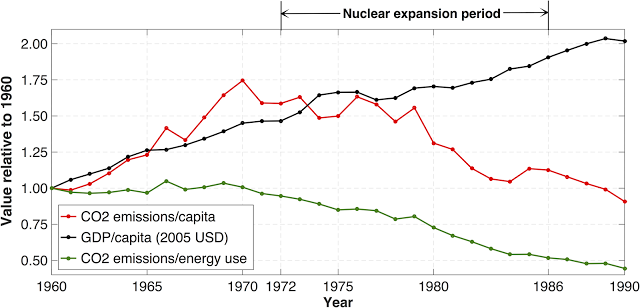Staffan Qvist, physicist at Uppsala University, and his co-author Barry Brook, an ecologist and computer modeler at the University of Tasmania, relied on comes from two countries in Europe to prove nuclear energy scaling: Sweden and France. The Swedes began research to build nuclear reactors in 1962 in a bid to wean the country off burning oil for power as well as to protect rivers from hydroelectric dams. By 1972, the first boiling water reactor at Oskarshamn began to host fission and churn out electricity. The cost was roughly $1,400 per kilowatt of electric capacity (in 2005 dollars), which is cheap compared to the $7,000 per kilowatt of electric capacity of two new advanced nuclear reactors being built in the U.S. right now. By 1986, with the addition of 11 more reactors, half of Sweden’s electricity came from nuclear power and carbon dioxide emissions per Swede had dropped by 75 percent compared to the peak in 1970.
France, a larger nation, has a similar nuclear tale to tell, weaning itself from imported fossil fuels by building 59 nuclear reactors in the 1970s and 1980s that produce roughly 80 percent of the nation’s electricity needs today.
All that would be required for the Chinas, Indias and U.S.s of the world to emulate these two nuclear pioneers is “political will, strategic economic planning, and public acceptance,” Qvist and Brook write. For example, nations would need to commit to a single design for reactors, as occurred in France and Sweden, as well as mandates requiring utilities to build said reactors and financial support for the construction from the national government. “The state reacted to a crisis, at that time the oil prices, and implemented a plan, which quickly in 15 years had solved the problem,” Qvist says. “Analogies could be drawn to the crisis we have today: climate change.”
A best-case scenario for conversion to 100 percent nuclear power could enable the world to stop burning fossil fuels and start fissioning uranium for electricity within 34 years. Requirements for this shift of course would include expanded uranium mining and processing, a build-out of the electric grid as well as a commitment to develop and build fast reactors—nuclear technology that operates with faster neutrons and therefore can handle radioactive waste, such as plutonium, for fuel as well as create its own future fuel. “No other carbon-neutral electricity source has been expanded anywhere near as fast as nuclear,” Qvist says.
Abstract
There is an ongoing debate about the deployment rates and composition of alternative energy plans that could feasibly displace fossil fuels globally by mid-century, as required to avoid the more extreme impacts of climate change. Here we demonstrate the potential for a large-scale expansion of global nuclear power to replace fossil-fuel electricity production, based on empirical data from the Swedish and French light water reactor programs of the 1960s to 1990s. Analysis of these historical deployments show that if the world built nuclear power at no more than the per capita rate of these exemplar nations during their national expansion, then coal- and gas-fired electricity could be replaced worldwide in less than a decade. Under more conservative projections that take into account probable constraints and uncertainties such as differing relative economic output across regions, current and past unit construction time and costs, future electricity demand growth forecasts and the retiring of existing aging nuclear plants, our modelling estimates that the global share of fossil-fuel-derived electricity could be replaced within 25–34 years. This would allow the world to meet the most stringent greenhouse-gas mitigation targets.

Brian Wang is a Futurist Thought Leader and a popular Science blogger with 1 million readers per month. His blog Nextbigfuture.com is ranked #1 Science News Blog. It covers many disruptive technology and trends including Space, Robotics, Artificial Intelligence, Medicine, Anti-aging Biotechnology, and Nanotechnology.
Known for identifying cutting edge technologies, he is currently a Co-Founder of a startup and fundraiser for high potential early-stage companies. He is the Head of Research for Allocations for deep technology investments and an Angel Investor at Space Angels.
A frequent speaker at corporations, he has been a TEDx speaker, a Singularity University speaker and guest at numerous interviews for radio and podcasts. He is open to public speaking and advising engagements.



